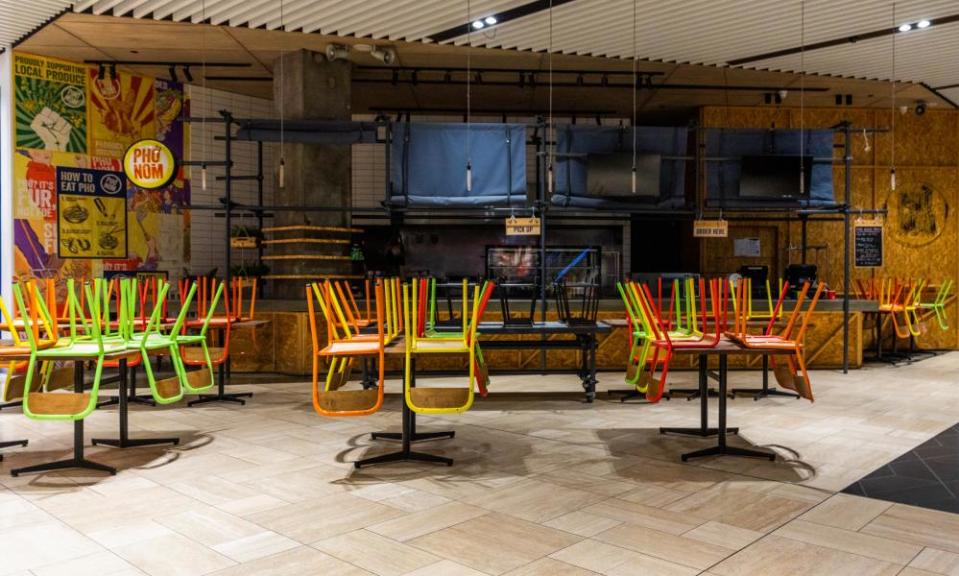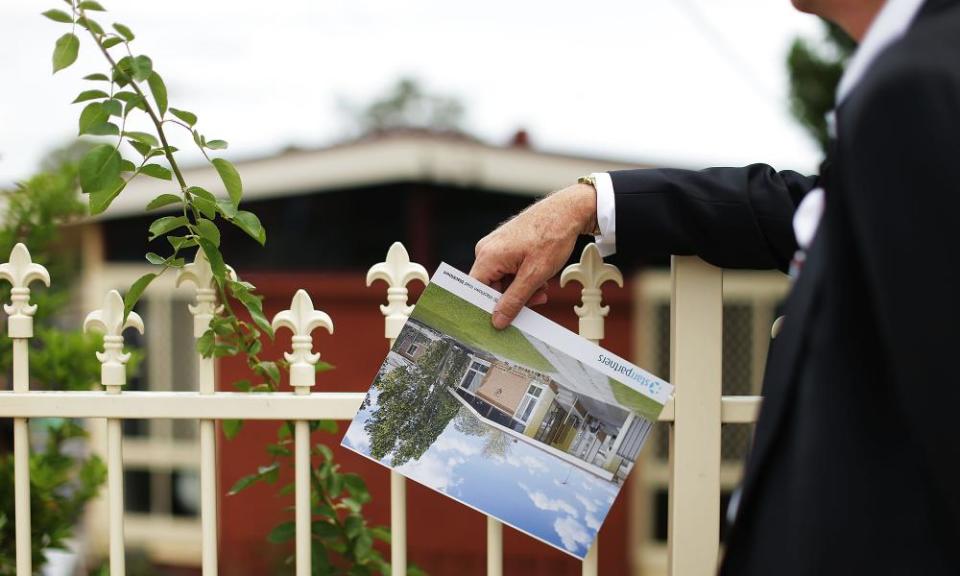Migration to Australia has fallen off a cliff – will it take the economy with it?

If Pritam Deb had waited another year, his dream of moving to Australia with his young family probably would not have come true.
The 35-year-old data analyst arrived in Australia from India in June 2019, after successfully applying for a permanent visa for skilled workers. After a few months searching, he now works as a contractor for a large telco.
“I was lucky enough to get in with my family before it broke,” he says. “And I was lucky enough to find a job. The timing was really, really important, and I’m quite fortunate.”
A year on from his arrival, Australia’s borders are essentially closed and migration has fallen off a cliff.
Since March, non-citizen non-residents cannot enter the country, the Australian government is advising people to reconsider the need to apply for Australian visas, and Australians are banned from leaving, with even dual citizens requiring special permission to leave the country.
The tough border closures, a key bulwark against Covid-19, mean that net migration is now almost at zero, and is certain to be just a sliver of previous government forecasts in the year ahead. In May, the prime minister, Scott Morrison, estimated annual migration of 34,000 in the year ahead – a far cry from pre-coronavirus estimates of around 270,000, and from the 2019 figure of 210,700.
Even with a vaccine and reopened borders, it could be years before Australia can meet those targets again.
Hamsini Addagatla is not as lucky as Deb.
The 27-year-old graduated from her postgraduate degree at a university in Sydney in December and planned to use her temporary graduate visa to do a professional year program, which includes an internship. Then she wanted to apply for a permanent visa and build an IT career in Australia.
Instead, she is stuck in the United States as the time left on her visa ticks down. In early March, a family emergency called her away to visit her sister in San Francisco, with a return flight booked for 4 April. Morrison announced the border closure on 19 March, to begin the very next day.
“I was completely devastated because I didn’t expect it to be so soon,” she says. “Then I thought, ‘OK, I’m a student, maybe they’ll allow me in in July,’ but I’ve just been waiting, waiting.”
Her visa expires in September 2021 and she needs a year left on it when she begins the professional course, which she cannot do remotely, and which she has carefully saved for.
That means if she does not make it to Australia by September 2020, “there’s basically no point in coming back”, she says.
She has applied for exemptions from the travel ban three times but has been rejected. She is still paying rent, utilities, phone bill and insurance for her life in Australia.
“It’s emotionally and physically draining me, because there’s nothing I can do at this stage apart from just applying again and again,” she says.
Apart from the immense personal impact on people like Addagatla, the nosedive in migration is certain to have a significant impact on the economy. But exactly what that impact entails depends on who you ask.
An immigration-dependent economy
“Australia’s entire economy is based on immigration,” says Liz Allen, a demographer at the Australian National University.
Migration is the major driver behind Australia’s population growth, which in turn has driven economic growth.
The dramatically reduced numbers of international students coming to Australia has already hit the higher education sector. But Allen says that’s just the tip of the iceberg.
“Migrants contribute to demand and supply sides of the economy and bolster the socioeconomic wellbeing of this nation in ways many don’t realise,” she says. The food we eat, homes, towns, hospitals all rely on migrants, and businesses depend on them.
“Without migrants, Australia’s future feels less certain, because the grim reality is that the economy needs the inputs of migrants to ensure our standard of living doesn’t decline,” she says.
As a result, the Covid-induced cut to immigration will probably have “significant and lasting” impacts that may take years to realise.

Abul Rizvi, a former deputy secretary of the immigration department, agrees. “The virus and the drop in net migration will combine to hit us very, very hard,” says Rizvi.
Rizvi says that migration and the economy normally “follow each other very closely”, though “which drives which is a chicken and egg question”.
But the chief economist for the Australia Institute, Richard Denniss, says that unimpressive economic growth is not always a bad thing for individual Australians, drawing a distinction between GDP and GDP per capita.
“Slowing population growth will lead to slower economic growth. Full stop. No debate about that at all,” Denniss says. “But that doesn’t mean our income per person is going to slow down. They’re quite separate.”
He says that despite Australia’s heavy reliance on population growth to drive economic growth, “for decades we’ve been silent about whether the benefits of that growth were flowing to individuals”.
Rizvi says that Australia targets skilled migrants, who get relatively well-paying jobs relatively quickly, which adds a positive per capita impact on the economy.
Slowing the population’s ageing improves per capita economic growth, he says.
Australia’s migration program targets people from about 20 to 35, and because of their relative youth, migrants will have disproportionately more children in the future. Migration has made Australia among the youngest developed nations on the planet, with a median age of 37.
That means that a fall in migration will decrease the birth rate and accelerate the Australian population’s ageing, he says.
“Those are just almost givens now,” Rizvi says. “That will hurt us.”
High unemployment
The debate about Australia’s immigration and its effect on unemployment rates is vexed and groups as disparate as One Nation and the ACTU have been critical of the system, even during a strong jobs market.

But unemployment is now predicted to exceed 9% by Christmas.
Some suggest this means we should be slow to welcome migrants back, lest they take jobs Australians could fill. Labor’s home affairs spokeswoman, Kristina Keneally, came close to this argument in a May op-ed that said Australia should change the size and composition of the migrant intake after the crisis.
Australia should “[shift] away from its increasing reliance on a cheap supply of overseas, temporary labour that undercuts wages for Australian workers and takes jobs Australians could do”, she argued, describing reliance on high migration levels to fuel economic growth as a “lazy approach” and advocating for investment in skills and training.
Rizvi and Allen told Guardian Australia that migrants don’t tend to take jobs Australians would otherwise do, because they’re either bringing skills Australians lack or doing low-skilled jobs that Australians don’t want to do.
“Australia’s migration scheme is demand-driven, meaning migrants aren’t stealing locals’ jobs,” Allen says. “Migrants do more than fill jobs locals can’t or won’t do. Migrants help build consumer sentiment and so have a bit of a turbocharge impact on the economy.”
Denniss says the effect of restarting the migration program on unemployment levels is nearly impossible to predict.
“We’ve now got 1.5 million people on unemployment benefits. It’s not at all clear whether bringing in an extra 250,000 people is going to lead to unemployment rising or falling,” he says. “There’s two offsetting effects: 250,000 people coming here and spending money will create some demand. And 250,000 people coming here and saying ‘can I have a job’ is going to increase the supply of labour. Which effect will be bigger?
“We’ve never played this game before. There’s no historical or international comparator,” Denniss says. “So choose your poison.”

Housing and infrastructure
By reducing demand for housing stock, the fall in migration will likely affect the housing market.
“We have a chronic undersupply of housing generally, which is one of the reasons Australian housing is so expensive,” says Michael Fotheringham, the executive director of the Australian Housing and Urban Research Institute.
Because the construction sector generally keeps pace with a growing population and demand for residential construction, the fall in migration will leave that sector with spare capacity, Fotheringham says. While that could lead to unemployment and underemployment, it also creates an opportunity to “rethink how housing development occurs in this country”.
Related: Coronavirus means Australia won't meet migration forecasts for a decade
Fotheringham suggests the construction of social housing as a solution that would help both the construction sector and those who are struggling to afford accommodation.
Falling migration will also affect the urban environment. The impact will be felt most strongly in Sydney, Melbourne and south-east Queensland, where migrants tend to settle, Fotheringham says.
It gives decision-makers more time to consider how these cities should be shaped in the years to come.
We can “do it carefully, not slowly, but more thoughtfully than when we’re chasing our tail”, Fotheringham says. “If in the past, supply was chasing to meet demand, we’ve got the opportunity for supply to shape and direct demand.”
The recovery
Assuming a vaccine is developed and Australia can reopen its borders in the next year or so, what will happen next?
Rizvi and Allen believe it could take years for Australia to get back on track. Forecasts of annual migration of about 270,000, laid out in the 2019 budget, will not be met for the rest of the 2020s, Rizvi suggests.
As the borders reopen, overseas students, visitors and working holiday-makers will gradually start returning and pumping money into the economy.
But unemployment is likely to still be high, so the reopening should be done strategically, Rizvi says. Decision-making should not be about “just going for numbers [but] about designing it right”.
Skills will have fallen away because of the recession, and there will be urgent demand for skills that cannot be generated through short courses.
Attracting skilled migrants is more difficult in a weak economy, and the government needs to make sure visa arrangements make Australia competitive for those highly skilled people. However, it is a “huge advantage” that Australia has done comparatively better in the pandemic than most other countries, Rizvi argues.
Deb says that moving to Australia was already a “huge risk” before the pandemic, and it might be too much for some even once borders open.
“I’ve seen a lot of people talking [online] about this and their apprehension about how it has impacted the markets,” he says. “People like myself, if you had a stable job back home and you had permanent residency, you’d be reluctant to take a chance in these troubled times.”
For some, like Addagatla, the reopening will be too late. She can’t extend her graduate visa, and she feels like the doors of permanent migration to Australia are closing to her.
“I just don’t see why they don’t allow visa holders to come back in, especially students and recent graduates,” she says. “This is why we came to Australia. I’ll be doing the quarantine for 14 days, I don’t see why I’ll be a risk to the community.”
Whenever the reopening happens, the experts Guardian Australia spoke to see an opportunity in the crisis to reshape policy.
“This is the sort of thing to give us pause to think about what sort of society we want to create going forward,” Fotheringham says.
“The current crisis allows an opportunity of reform, and Australia should grab that opportunity with both hands and run with it,” Allen says.
“A cohesive population policy – incorporating climate measures, gender equality provisions, and promoting social equality – can help us pave the way out of this mess. It will take hard work, but now’s the time. From this crisis we can build a stronger and fairer nation, it just takes commitment and leadership.”

